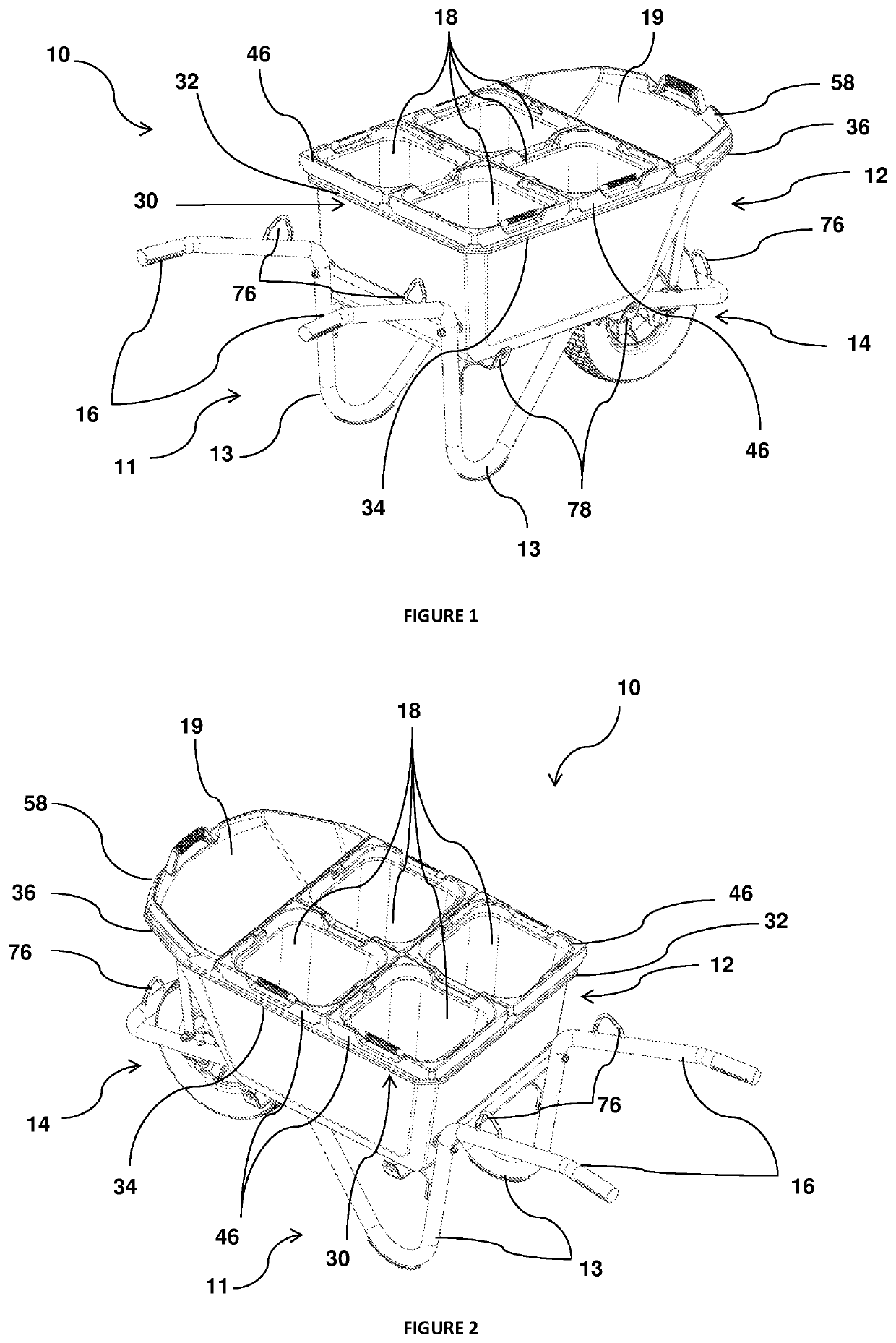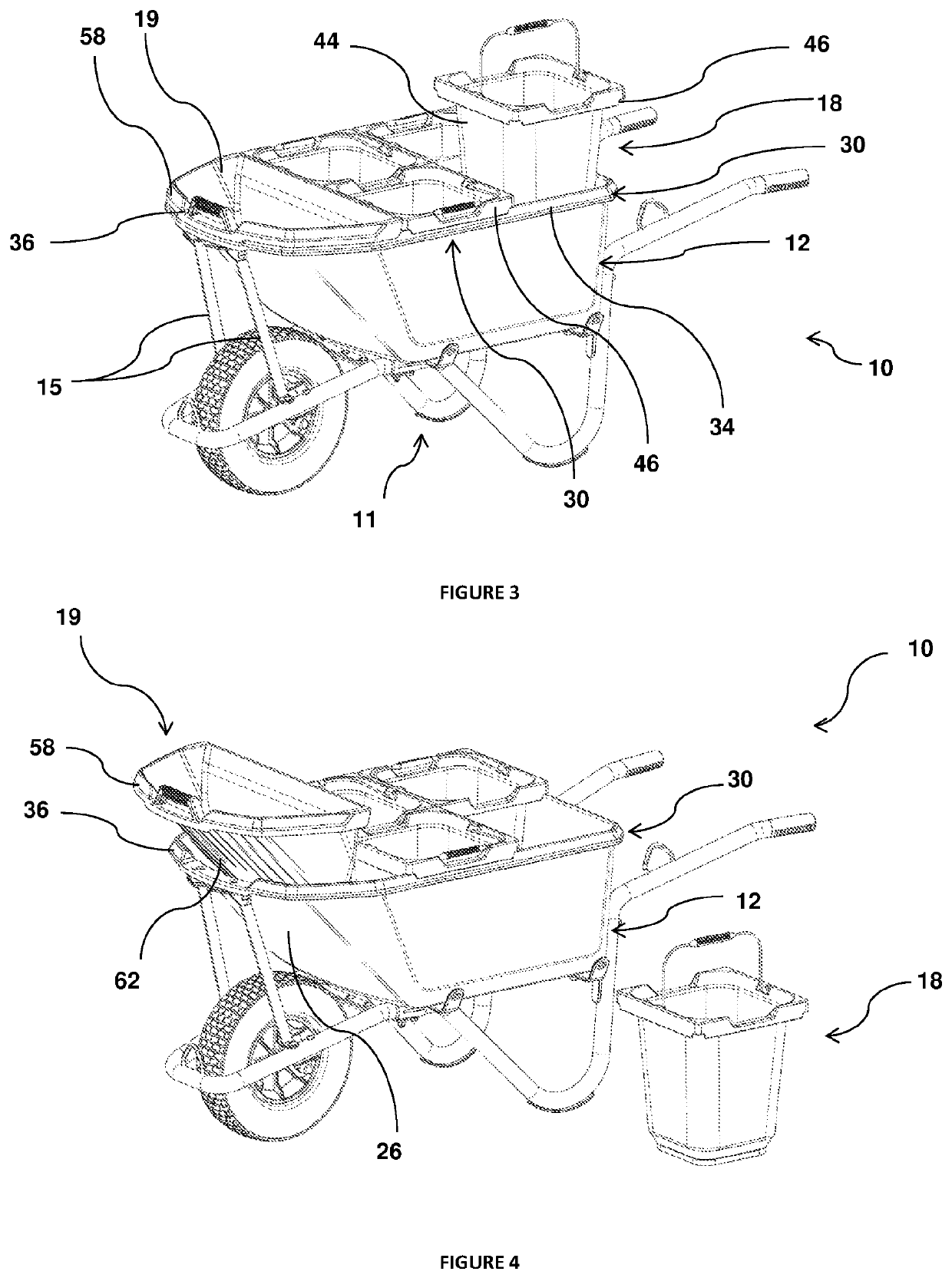Wheelbarrow
a technology of wheelbarrows and sleds, which is applied in the field of wheelbarrows, can solve the problems of damage to vehicles, unsafe or impossible to traverse, and difficulty in lifting a loaded wheelbarrow to the necessary elevation in order to tip, so as to facilitate connection to a lifting device, facilitate transportation, and facilitate the effect of movemen
- Summary
- Abstract
- Description
- Claims
- Application Information
AI Technical Summary
Benefits of technology
Problems solved by technology
Method used
Image
Examples
third embodiment
[0113]FIG. 16 illustrates a wheelbarrow 200 according to the present invention having an oval-shaped 80 litre tub 212 and a 3-compartment configuration consisting of a pair of 15 litre buckets 218 and a single 15 litre scoop 219. Tub 212 has a lower profile or shallower configuration and may therefore be particularly suited to use with a domestic concrete mixer which are often located close to the ground. The rear of tub 212 is left unoccupied by a compartment so as to allow, for example, gloves, spades or other items to be carried in front of the operator. In alternative forms, wheelbarrow 200 may be fitted with a pair of scoops 219 at either end of the tub 212.
[0114]FIG. 17 illustrates a wheelbarrow 300 according to a fourth embodiment of the present invention including a 110 litre tub 312 similar in profile to tub 12 of the first embodiment but for a cut-out 380 in the lower rear section such that the rear portion of the tub 312 is shallower than the front portion. Cut-out 380 th...
fifth embodiment
[0117]FIG. 18 illustrates a wheelbarrow 400 according to the present invention having a 7-bucket extended tub 412. Seated upon the rim 430 of tub 412 are six buckets 418 and one scoop 419. At the rear of wheelbarrow 400 is a one-piece handle 416. As compared to the foregoing embodiments, wheelbarrow 400 includes additional buckets therefore allowing for a larger amount of material to be transported. Wheelbarrow 400 includes a wheel assembly comprising a pair of wheels 414 located on opposite sides of the tub 412.
sixth embodiment
[0118]FIG. 19 illustrates a wheelbarrow 500 according to the present invention. As distinct from the foregoing embodiments and illustrations, the tub 512 of wheelbarrow 500 includes a linear front wall 526 such that the profile and the rim 530 of wheelbarrow 500 are generally rectangular. As such, wheelbarrow 500 does not include a scoop compartment. Instead, wheelbarrow 500 includes six buckets 518. Wheelbarrow 500 is envisioned, in particular, for sorting applications such as fruit or vegetable picking where the tub 512 will seldom be used to carry materials directly and therefore a spout-shaped front wall is generally not necessary. Instead, wheelbarrow 500 includes six buckets 518 for carrying / sorting a variety of materials. Wheelbarrow 500 includes a wheel assembly comprising a pair of wheels 514 located on opposite sides of the tub 512.
[0119]It will be appreciated that, in contrast to the wheelbarrows illustrated in the foregoing Figures, wheelbarrow 500 includes a generally v...
PUM
 Login to View More
Login to View More Abstract
Description
Claims
Application Information
 Login to View More
Login to View More - R&D
- Intellectual Property
- Life Sciences
- Materials
- Tech Scout
- Unparalleled Data Quality
- Higher Quality Content
- 60% Fewer Hallucinations
Browse by: Latest US Patents, China's latest patents, Technical Efficacy Thesaurus, Application Domain, Technology Topic, Popular Technical Reports.
© 2025 PatSnap. All rights reserved.Legal|Privacy policy|Modern Slavery Act Transparency Statement|Sitemap|About US| Contact US: help@patsnap.com



